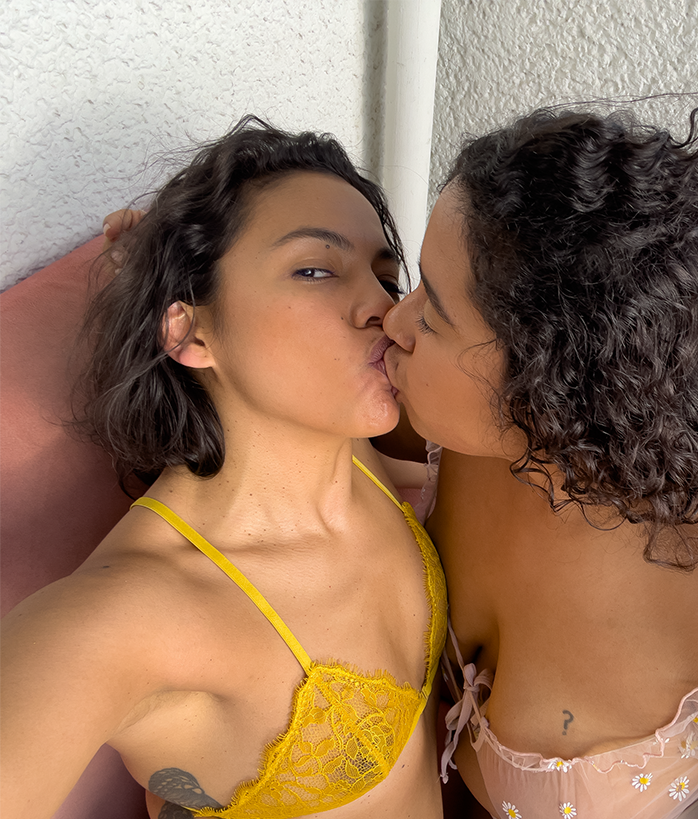
An afternoon filled with presentations
11.12.2022
Jester Artists
An afternoon filled with presentations
11.12.2022
On the 11th of December, we come together for the finissage of Marie Zolamian’s exhibition, and the end of a major chapter of our organisation. At the end of 2022, the programme initiated still under two organisations, FLACC and CIAP, comes to an end. We are grateful for the last years and for the experiences and encounters they brought. We are looking forward to starting 2023 with new ideas, energy, and humour – in the style of Jester.
Some of our artists will share elements of their research or project on this special day. Alongside, we will hold a goodbye drink with some departing colleagues. Luuk Nouwen worked for ten years as artistic director at FLACC and the last year as senior supervisor artistic projects at Jester. Tine Deboelpaep worked for the past years as an artistic employee at CIAP and Jester. Lisa Costantini worked for two years at FLACC and Jester in administration and for the ceramics studio.
Programme:
- 2 p.m. – presentation ‘The Forest Underground’ (audio piece) by
Miriam Sentler & Drake Stoughton (C-mine design centrum, downstairs*) - 3 p.m. – artist talk with Sarah van Sonsbeeck and Rana Hamadeh,
moderated by Orlando Maaike Gouwenberg (small auditorium) - 4 p.m. – tour exhibition by Marie Zolamian &
goodbye drink (exhibition space) - 5 p.m. – screening ‘Terms of Intimacy’ by Helen Dowling (work in progress) and a conversation with Helen Dowling and Jo-Lene Ong (small auditorium)
- 6 p.m. – presentation by Alain Nsenga (small auditorium)
It is the final day of Marie Zolamian’s solo show ‘Droomland’. Seize the last chance to be wowed by ‘Symbiocene’, one of the artist’s largest paintings to date: an impressive landscape, stretching effortlessly across the width of the exhibition space. The work takes you into a colourful, mysterious universe that emerges from Zolamian’s oeuvre and reflects on the political meanings of the landscape in contemporary context.
Miriam Sentler presents her audio installation ‘The Forest Underground’, developed in collaboration with composer Drake Stoughton. The duo has been inspired by the sounds and the acoustics of the coal mines, where the voices of birds, crickets, and trees were heard on a daily basis while accompanying the miners. In their piece, Sentler and Stoughton compose a quasi-fantastical, transhistorical soundscape of that ‘underground forest’. The work will have its premiere on December 11th, followed by a conversation with the artists. You can read more about the project here.
Helen Dowling will give us a glimpse into her upcoming film and ongoing research initiated in 2020 with the support of Sint Lucas Antwerp and continued during her research at Jester. ‘Terms of Intimacy’ engages the image of sexuality and femininity in mainstream pornography by developing strategies to repurpose the acting and means of production within custom pornography. As part of the research, Dowling has been working on a new film, in collaboration with Custom Performers. Fragments of the work in progress will be presented, and the screening will be followed by a conversation with the artist. You can read more about the project here/below.
At Jester, Sarah van Sonsbeeck continued her research into ‘immaterial architecture’ – things that affect our living environment that might not be immediately tangible or escape our control – such as molehills, which inspired her most recent series of ceramic and bronze works. Rana Hamadeh’s interdisciplinary projects often question the authority of historical voice, creating visibility around erased or unrecorded voices. In theatrical performances, sound works, texts or games, she creates space for discursive approaches to subject matter. At Jester, she tested the waters of becoming a game designer and ceramicist. We host a conversation between the two artists about their practice, moderated by Jester’s artistic director Orlando Maaike Gouwenberg.
Alain Nsenga comes from a miners’ family. This personal story fueled his fascination with the history and impact of mining across the globe. For his research, he interviewed miners from Congo and Limburg, and discovered links between their stories of migration, hard labour, and underground friendships. On the 11th, he will present parts of the research that was earlier on show at Z33 as part of On Trade Off – Charging Myths.
“The Forest Underground” by Miriam Sentler and Drake Stoughton was realised with the support of Jester, Emile van Dorenmuseum and O&O subsidy of CBK Rotterdam.
Related Projects
Droomland
10.09–11.12.2022

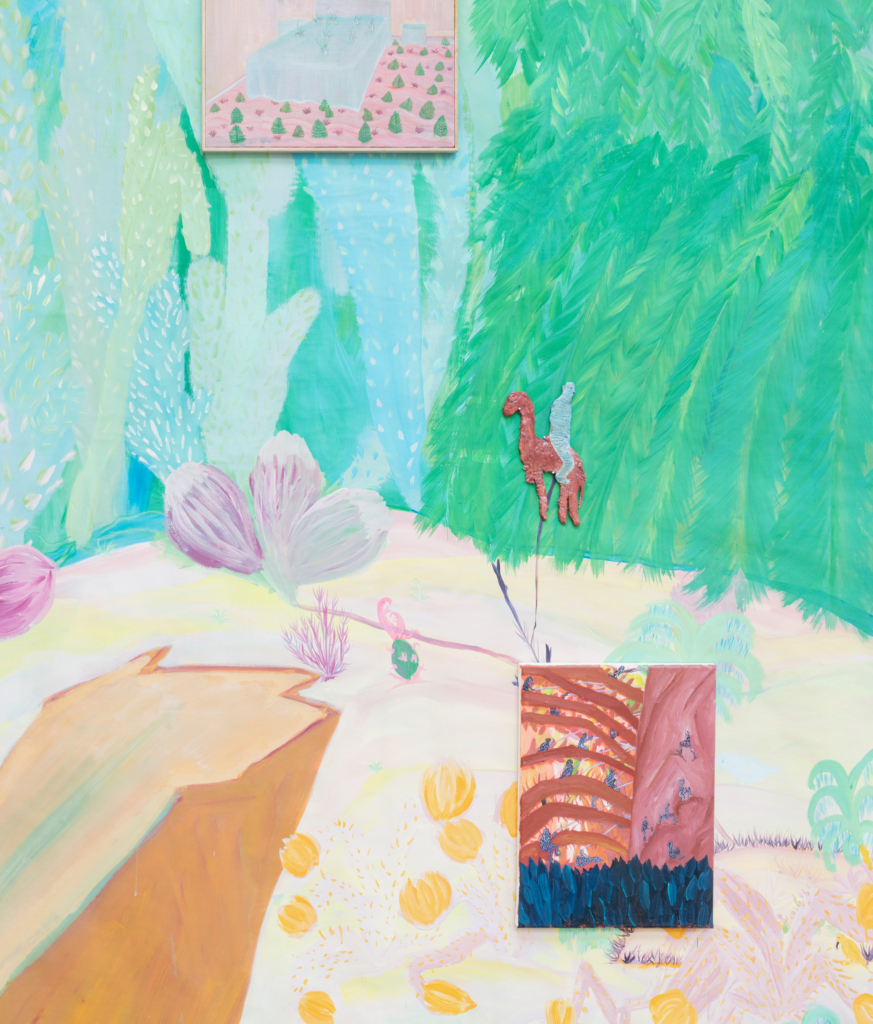
Kids Arts Day
20.11.2022
Workshop Marie Zolamian
Kids Arts Day
20.11.2022
For Kids Arts Day and on the occasion of Marie Zolamian’s exhibition ‘Droomland’, currently on show at Jester, we organize a special workshop inspired by her works. The monumental painting ‘Symbiosene’ is the centerpiece of the exhibition. In this colourful scenery of 14 m long, individual, smaller artworks are integrated.
In a playful manner, children discover Marie Zolamian’s wonderful universe and learn how to use all kinds of drawing and painting materials. We create smaller artworks, which we will put together into one big canvas, just like Marie’s work!
PRACTICAL INFORMATION
The workshop will take place on Sunday November 20th, at Jester’s exhibition space, from 2pm till 5pm. You can find us on the 1st floor of the C-mine energy building. Children can work throughout the afternoon to create their works under the watchful eye of our instructor(s). The workshop was designed and will be guided by artist Fee Veraghtert. At 2pm, 3pm, and 4pm, she will provide an introduction about how to get inspired by Marie Zolamian’s work and the available materials.
Participation in the workshop is free of charge. Note that it can get ‘wild’ with the markers or paint! Be sure to bring an apron or old t-shirt to protect your nice clothes. Any questions? Mail to tine@jester.be



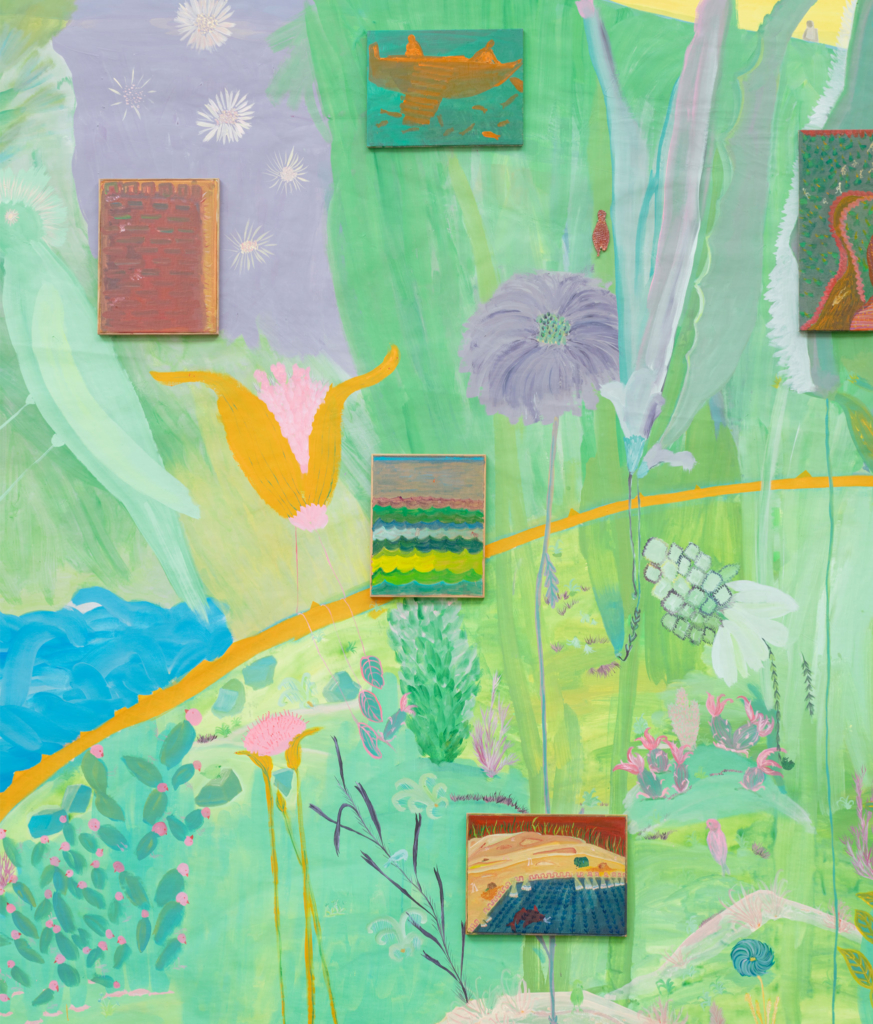
Art Trip Marie Zolamian
28.10.2022
‘Droomland’, Jester & 'Welkom - Bienvenue - Welcome - Willkommen', KMSKA
Art Trip Marie Zolamian
28.10.2022
Marie Zolamian – ‘Symbiocene’, 2022, © photo: Michiel De Cleene
We dedicate Friday the 28th of October to the artistic practice of Marie Zolamian. We delve into her work through ‘Symbiocene’ and ‘Welkom – Bienvenue – Welcome – Willkommen’, the two monumental works recently created by the Liege-based artist. We will bring together art lovers from Liège and Limburg to visit both artworks in Genk and Antwerp. Do you also want to join?
The painting ‘Symbiocene’ is the centrepiece of Marie’s solo exhibition ‘Droomland’ at Jester. The painting is so large that it takes up almost the entire width of the exhibition space. In the work nature and the landscape flourish and touch upon political urgencies and art-historical references. Together with Marie Zolamian, we dive into her mysterious, visual language and unravel the connections and narratives the work incorporates.
During KMSKA‘s opening weekend on the 24th and 25th of September, Zolamian’s commissioned mosaic in the peristilium called ‘Welkom – Bienvenue – Welcome – Willkommen’ was not publicly accessible due to a platform barricading the passage. The artist agreed to the placement of the platform, on the condition that an official inauguration for all museum commissions would follow later. In the meantime, it was announced that Lili Dujourie’s work ‘Mimesis’ would be inaugurated to the general public on 28 October. Unfortunately, Zolamian was told by the museum that her mosaic would not be part of the festivities.
While waiting for an official inauguration by KMSKA, we already invite you to the exclusive inauguration of ‘Welkom – Bienvenue – Welcome – Willkommen’. For the creation of her work, Marie delved into the archives and collection of the museum. During this inauguration, the artist will provide extensive explanations of her work. Afterwards, you are free to explore the museum and view the presented collection pieces spanning seven centuries. Note: the museum closes at 5 p.m. For those who have seen enough art that day, we find a nearby cosy café to hang out. In the evening, we will gather for the return trip with stops in Genk, Hasselt and Liège.
PROGRAMME
11:00 a.m. Departure Liège Guillemins station, parking 2
11:40 a.m. Departure Hasselt, parking at the back of CCHA
12:00 Arrival Jester, Genk
- Introduction: by Artistic Director Orlando Maaike Gouwenberg
- Explanation ‘Dreamland’ by Marie Zolamian
- We provide a sandwich lunch + coffee/tea/water during the lunch break
*tip: not hungry yet? Feel free to bring your lunchbox for a snack later on
1:00 p.m. Departure from C-mine parking 2 to Antwerp
2:00 p.m. Arrival KMSKA (in case of heavy traffic on the road around 14:30)
- Inauguration of mosaic by Marie Zolamian and welcome speech
- Followed by a visit to KMSKA & ‘Mimesis’ Lili Dujourie or a cosy café hang out.
Note the KMSKA closes at 17:00!
5:30 p.m. Meeting before return from Antwerp
- Arrival Genk around 18:30
- Arrival Hasselt around 19:00
- Arrival Liège around 19:30
PRACTICAL INFORMATION
– 45 euros members: only visiting the mosaic
– 65 euro members: incl. admission ticket KSMKA collection
– 55 euro non-members: only visiting the mosaic
– 75 euro non-members: incl. admission ticket KMSKA collection
*price includes bus trip+ coffee or tea+ sandwich lunch. Depending on the chosen tariff, you indicate whether you would like a ticket to the KMSKA collection or not. We will make the reservation for you. Let us know if you have a museum pass, we will calculate your discount.
Please note: if there are fewer than 10 participants from Liège, it will be cancelled and the entry fee will be refunded. Before the start of the trip, registered participants will receive further practical information via e-mail. If you have any questions in between, you can always contact us! Do not forget to renew your membership if necessary. This can be done via this link or via info@jester.be. More info on our memberships can be found here
Marie Zolamian – ‘Symbiocene'(detail), 2022 © photo: Michiel De Cleene
HOW TO RESERVE?
Send us an email with the subject ‘Art trip KMSKA’ by 25 October to info@jester.be containing:
- the number of participants and everyone’s names
- contact details
- billing details and whether you want to visit KMSKA (Let us know if you have a museum pass or not)
- Point of departure Luik, Hasselt, Genk
- Any allergies or type of diet we can take into account
Your registration is complete after transferring the participation fee to BE44 1324 3606 3945
Related Projects
Droomland
10.09–11.12.2022






Exploring the underground forest
Interview
Exploring the underground forest
a conversation with Miriam Sentler and Kristof Reulens
Dutch artist Miriam Sentler is one of the residents at Jester in 2022. In conversation with Kristof Reulens, the coordinator for arts and heritage at the City of Genk, and Jester’s curator Alicja Melzacka, she is sharing her research and looking back at her three-week long stay at the Emile van Dorenmuseum.
Alicja Melzacka:
Miriam, as an artist and researcher, you’ve been dealing with fossil fuel landscapes for a while. How did your previous experience translate into the context of Genk? What astonished you?
Miriam Sentler:
When I came to Genk I had certain expectations regarding mining sites. For several years, I have been researching the lignite industry in North-Rhine Westphali, where the local forest is disappearing, ecosystems are being excavated, birds and people are being driven out of the landscape. As it turned out, Genk is an entirely different context. I was confronted with the fact that there is so much nature around in the first place. It has to do with the different ways in which lignite and black coal are extracted – the first one requires excavation of large pieces of landscape, so-called ‘strip mining’, while the latter is found deep underground. So, I was coming from a barren landscape in Germany to a rich, ‘new’ landscape in Genk.
During my stay here, I soon discovered a very different kind of relationship with the landscape. I became interested in the fact that a lot of what’s now considered ‘nature’ has emerged because of the industry. In Genk, we are historically talking about a heath landscape, where there weren’t many trees to begin with – most of them were planted for industrial purposes. The so-called ‘mine arboretum’ is one example of such industrialisation of nature, but also the forest management by the wood industry, or the planting of trees to prevent the sand drifts, which was practised already in the mediaeval ages. In fact, humans have always shaped nature around here.
AM
In this new context, what triggered your interest the most? Have you found a new line of inquiry while working in Genk?
MS
I was most interested in the material agency of nature in relation to the industry – how, on the one hand, nature was exploited by the mining industry and, on the other hand, how plants and animals were assigned specific agency by the workers. It was something that occurred to me when I was looking into different linguistic expressions, for example: ‘de kanarie in de koolmijn’ (the canary in the coal mine) and ‘grenen spreekt voordat het breekt’ (pine speaks before it breaks). They convey an interesting sense of listening to that nature, and at the same time, industrialising and deploying it in a specific way, also in order to save lives. That’s what was perhaps the most striking to me, the agency that this exploitative industry itself assigned to nature. Then, the second part was, of course, the history of landscape painting in Genk, which I got to know during my stay at the Emile Van Dorenmuseum.
AM
You had an opportunity to live in the museum’s historical building, which was built by landscape painter Emile van Doren, one of the founders of the artists’ colony in Genk at the turn of the 18th and 19th centuries. What did you find the most interesting about this part of Genk’s history?
MS
One thing was certainly the idea of going back in time; the attitude of a painter going into the landscape and not drawing the emerging industry but looking away, towards the heath. It made me think of this sense of deep time one might experience in the middle of the ocean, where nothing really changes. I was fascinated in particular by the painting of a carbonised forest by Jan Habex, which is taking this notion of going back in time even further.
Kristof Reulens
I also find this painting fascinating. It was commissioned by the mine of Waterschei. Why did the coal mine industry find it necessary to commission a monumental painting showing the landscape before human interference? It might be seen as a kind of scientific illustration of the geological period from which the resource originated, but still, it is quite a paradoxical gesture.
MS
Another thing which I found fascinating about Genk, and which also relates to the history of a specific painting, was the healing power of this landscape. The birch trees in Genk were utilised in different ways: firstly, by the wood and coal industries, secondly, by the landscape painters, and thirdly, for medicinal purposes. Priest and physicist Sebastian Kneipp claimed that the birch forest would heal tuberculosis, and in… a sanatorium was built in a nearby Bokrijk. This enormous agency of the trees is something I found really stimulating.
This medicinal application of nature is portrayed in that painting of François Halkett from 1885, entitled Dans la sapinière. The painting explores the notion of disappearance – someone enters the forest, stays there for a while, and then disappears completely. Only the clothes are left behind.
KR
This painting is shrouded in mystery. We only know a story as put forward in an article in De Groene Amsterdamer, dated 1885, one year after the painting had been completed. The painting represents a woman suffering from tuberculosis, a lung disease strongly linked to the industrial revolution. She visited Genk because it was believed that the wind blowing across the heather grounds and in the pine forests was cleansing. This scene is depicted in the first panel, where you can see the sick woman accompanied by her sister. In the third panel, you can see the pine forest which is a little bit taller, indicating the passage of time. Amongst the trees, there is a black veil with flowers. The story in De Groene Amsterdammer tells us that the woman did not survive the treatment. It has not been confirmed, but my view is that it’s a personal history of the painter, François Halkett.
François Halkett, In het Dennenbos – Dans la Sapinière, 1884, sketch in the collection of the Emile van Dorenmuseum
MS
In this story of trying to recuperate, to revive one’s body, I can see a kind of parallel with the state of the landscape itself. Compared to Germany’s disappearing forest, there is a ‘resurrecting’ forest in Genk, one that is still developing and still growing. This idea of resurrection is also represented by the so-called ‘canary resurrector’, which I came across during my research. It was a device used in the mining industry to revive birds which started to show signs of carbon monoxide poisoning.
These are different kinds of parallels, which I found in Genk, and which I want to work on further, primarily through sound. I think that sound is a suitable medium to map all this knowledge because sound specifically was utilised by the industry. Think of the crackling of wood, functioning as a warning against a mineshaft collapsing, and the singing of a canary, or rather its absence, when the carbon monoxide level would become dangerously high. This is precisely the idea of sentinel species, which can sense things humans cannot. I would like to look into this further with composer Drake Stoughton, to think about it in terms of sound and music history, where ‘resurrection’ is, of course, a common trope.
AM
Miriam, you worked with Drake before, on your sound piece ‘The Chase’, which you presented in Genk last year, during a lecture performance.
MS
‘The Chase’ emerged from my research into the lignite industry in Germany, and it was inspired by my family history. My great-grandfather was a miner coming from this area, and my grandfather always lamented the fact that his birthplace was excavated by the industry and turned into a lake. Starting from the lake, I researched the landscape and eventually ended up at Hambacher Forest, which is currently being excavated, amidst the protests of treetop activists.
In the mediaeval ages, Hambacher Forest used to be called ‘Burgewald’, which means the commons’ forest. There were certain rules of how to interact with this forest. The citizens were allowed to gather wood and berries, but they were not allowed to cut any trees or harm the forest. When the industrialists arrived there, about 200 years ago, they first started by rebranding the forest. Since then, it was no longer the commons’ forest but Hambacher Forest, related to the Hambacher mine. And so, the extraction could start. What remains of the forest today is only 10% of its original size.
‘The Chase’ was an attempt to archive the bird species of the disappearing forest because many people who were resettled from that area told us that what they missed the most were bird songs. We recorded the songs and transcribed them into a score. The resulting audio piece shows the impossibility of truly recording nature. With each line, you first hear the bird singing, followed by the musician trying to mimic the sound on the flute. But he can never actually ‘capture’ the bird, as if it was too smart for him.
AM
Could you tell us something more about the relationship between that project and your present research in Genk? You have been making on-site recordings, and you are going to work with Drake again – what approach do you assume this time?
MS
The new project is of course different, as it departs from a different context – while in Hambacher Forest things were disappearing, in Genk, they are emerging. That’s why, with Drake, we started talking about this resurrection in relation to music tropes. How were the religious chants written, where were they performed, and what was their social role? This is something still very apparent if you look at the effort put into constructing mine chapels, which in the end, also conveyed the power of the industry. Drake was also directly intrigued by the canary resurrector as a container for something, maybe even sound. We found it very particular that while the crackling of the pines served as a warning sign, in the case of the canary, it was the absence of sound that indicated the danger. To think about the resurrection is to think about death and life, about the absence of sound and the presence of sound.
KR
Now that I hear this story about the disappearance of the forest, I see some quite interesting parallels with Genk. The idea of a loss or a gain is different, and yet the same – I’ll try to explain why. You said that Hambacher Forest used to belong to the community. Also the heather grounds in Genk were called ‘gemene gronden’ (common lands). Everybody had the right to the land and could let their sheep graze on it. When in the 19th century, the government introduced the law of the savage lands, promoting the cultivation of pine forests – one of the few crops that could survive on the sandy soil – the locals protested and peasants went on strike because they were losing their communal grounds. It is a pretty similar development to the one you described in Hambacher Forest, with the industry taking over a common resource. So what you see now as a resurrection would not be perceived this way by the 19th-century farmers. They saw the coming of the pine forest as the death of their way of living. Who has the right to the landscape? How do these ideals change with time? There is always a communal idea behind, I think, being ‘the people’ vs ‘the industry, but it is always in movement. It’s a cycle, where you will always have the resurrection and the disappearance over and over again.
AM
Raymond Williams uses the metaphor of an elevator to illustrate this relativism of the notion of ‘nature’. He was referring specifically to the evolution of pastoral writing, but this metaphor might as well be adapted to other contexts. He said that no matter how far back we go in our analysis of the notion of nature (and its representations in literature, art, etc.), there has always been lamenting about the loss of a more ‘real’, more ‘natural’ way of living. He compares this to a moving elevator, which keeps going further backwards, constantly looking for a more utopian, arcadian vision of nature. This image of an elevator resonated strongly with me because it is rather unusual to spatialise the temporal dimension along the vertical axis. And this image of an elevator going underground, deep into geological time, resonates also with the context of the mine.
KR
A good example of this relativism is, for instance, the lake district of Genk – De Maten. Recently, many trees have been cut down there, which provoked a large protest. But that decision was actually taken by Natuurpunt, the keepers of this landscape, to preserve that landscape in its desired state. To protect this landscape, you have to keep it quite barren because the trees with their roots have an impact on the slope and the cascades and can disrupt the ecological system that developed in De Maten over the centuries. What makes it even more complex is the fact that there is nothing ‘natural’ about the system of lakes and cascades that this area is known for – it was man-made in the mediaeval ages to farm fish. But, of course, when the landscape painters arrived in Genk, they saw this large lake district and thought that it was ready to be painted. The reflection of light in the water was a big topic, especially in the 19th century. Historically, these aesthetic considerations also played a role in nature preservation. I know that when it was first spoken about founding a nature reserve in Genk, in the years before the First World War, there were several arguments put on the table – biodiversity was one, but the aesthetic view of the landscape was another one.
So again, we have clashing visions on what the ‘natural’ state is, and what is worth preserving. On top of that, we have different economic agendas, of how to use the land to one’s benefit, whether it’s for farming, wood or coal industry, agriculture, tourism… I’m pretty sure that Emile Van Doren or Armand Maclot would be behind the Natuurpunt when they were opening the landscape up again and cutting down the trees. But maybe from an ecological point of view, leaving the trees to grow and create a new biodiverse ecosystem might be an argument of today, so which argument do you choose?
MS
So, maybe there is no original landscape in Genk?
KR
Maybe that’s the landscape that Jan Habex painted? I don’t know.
KR
I want to still return to the idea of the sound underground and share an anecdote about it. When the coal mines started to be active in this region, after the First World War, wood was no longer used to reinforce the mineshafts, it was substituted by steel support. I think that the mine arboretum, which was cultivated as a kind of testing ground for material research, quickly became obsolete. Of course, wood was still used for other than structural purposes in the mines. I also think that wood would have lost its signalling function because, in the 20th century, conveyor belts were introduced underground, and there was this constant noise which was absent from the 19th-century mines. The same goes for the canaries, which eventually were substituted by special mine lamps.
However, what I always found interesting were the stories about another kind of sound, told by the miners from this region. They said that in the mineshafts, you could hear the loud chirping of the crickets, which were transported there with the wood. This was the only natural sound they could hear…
MS
That’s fascinating. It is as if different times and stages of the industry had different natural sounds accompanying them. I think that there is a potential in bringing these various temporalities and sounds together in a hybrid soundscape: the geological time, the historical time, the idealised time; the trees, the birds, and the crickets. It’s quite evocative to imagine how they populate this forest, deep underground…
This project has been realised in collaboration with Emile van Dorenmuseum, with the kind support of the city of Genk, the Flemish Community, O&O Subsidy/ CBK Rotterdam, and the members of Jester.
Related Projects
The Chase
14.08.2021

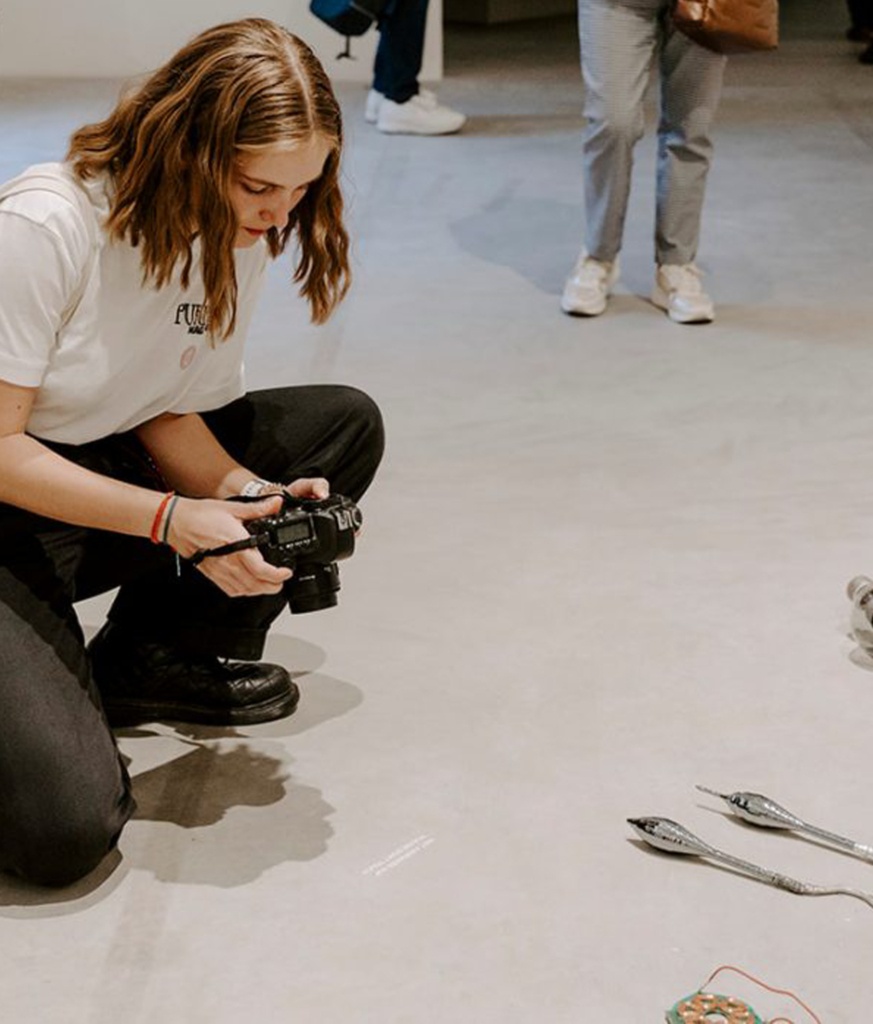
How do I photograph my work with a camera or smartphone?
24.09.2022
Workshop
How do I photograph my work with a camera or smartphone?
24.09.2022
Do you need good pictures of your visual work for your website, portfolio and social media? Would you like to make them yourself, but you don’t have the know-how? This practical workshop teaches you how to take good reproduction photos with a simple camera, even if you have little or no experience with photography.
Photographer and teacher Kristof Vrancken will lead the workshop. He will work with you in various test settings such as a studio and an exhibition space. You will learn to take reproduction photographs with a reflex camera, a compact digital camera or even your smartphone.
Practical information:
The workshop takes place on Saturday the 24th of September, from 10 a.m. to 4 p.m. You can find us at the following address: Casino Modern, André Dumonlaan 2, 3600. The workshop is free, but the number of places is limited to 8 participants.
Registration is required and is possible until Monday the 12th of September. You can access the registration form via this link. We will confirm your participation by Thursday the 15th of September.
Want to follow more workshops?
VONK, Z33 and Jester (the former CIAP/FLACC) join forces to organise a series of workshops about the practice of the visual artist. The workshops will help you take your first steps and offer you tools to get started afterwards.
The workshops are intended for professional, semi-professional and/or starting contemporary artists with a Limburg connection who have followed professional art training. The workshops are held in Dutch, are free of charge, but the number of places is limited.
Keep an eye on our website for more information about the future workshops:
Saturday the 15th of October | Workshop strategic thinking and business management
Friday the 18th of November | Portfolio Day

©Documenta fifteen
Graphic design: Studio 4oo2

©Documenta fifteen
Graphic design: Studio 4oo2
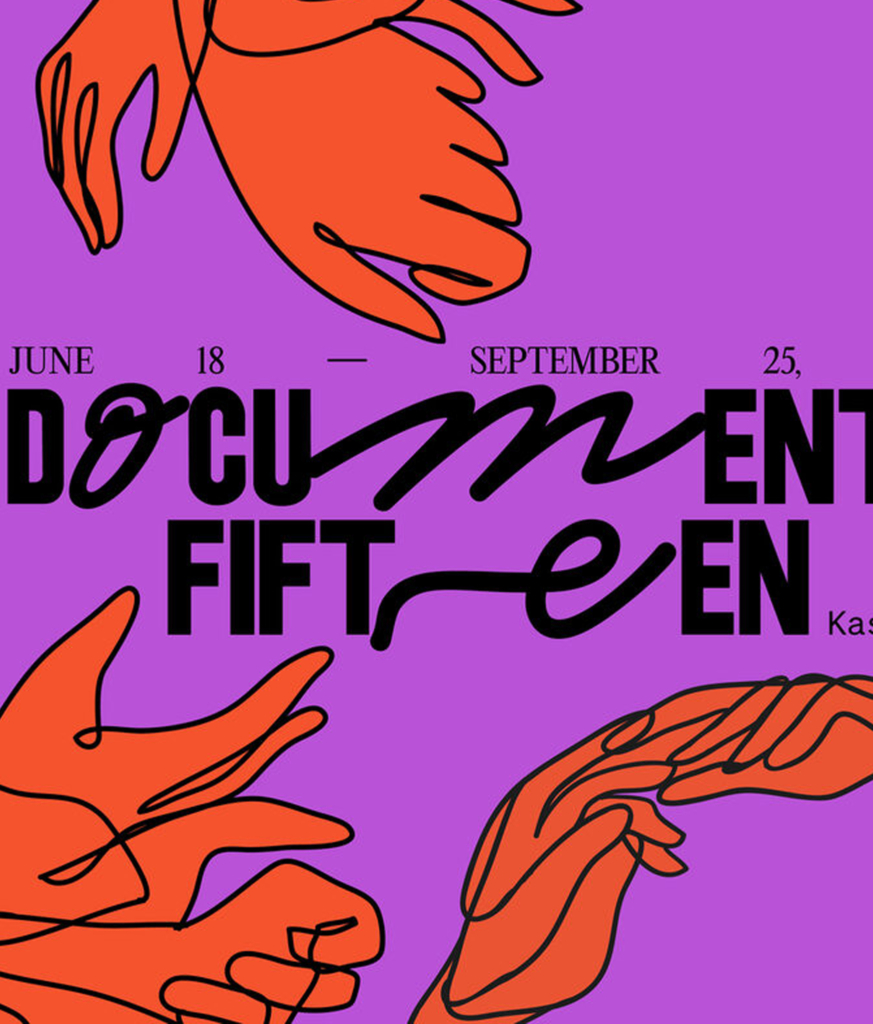
Art trip
16–18.09.2022
Documenta Fifteen
Art trip
16–18.09.2022
Once again, we organize a three-day bus trip to Kassel to visit DOCUMENTA fifteen! We are looking forward to another great weekend!
Programme
- 16.09.22: Bus trip towards Kassel with short stop, arrival at hotel, visit to Documenta
- 17.09.22: groupvisits and free moments
- 18.09.22: Check-out of hotel, visit to Documenta, bus trip back to Limburg with short stop.
* More details will follow soon
PRACTICAL INFORMATION:
Members price per person
- 420 euro for a double or twin room
- 550 euro for a single room
Young members price per person
- 380 euro per person for a double or twin room
Price non-members per person
- 470 euro for a double room
- 600 euro for a single room
The participation fee includes the bus trip, 2 overnight stays with breakfast, a cancellation and assistance insurance. What is not included in the price? Personal expenses, meals, drinks, etc. Entrance fee for Documenta (we will book this on the spot, so everyone can get the discounted price they are entitled to).
HOW TO BOOK?
E-mail us before 24.07.22 to info@jester.be with the subject: trip KASSEL. In your mail, be sure to include the number of participants, everyone’s names, contact details, billing details, your preferred room type and which participants are or are not members of us. Attention! Your registration is only complete after the transfer of an advance payment of €100 per person to BE44 132 4360639 45. Please mention: KASSEL+name + number of participants (number of members)+ room type.
As soon as we have received the bank transfer, you will receive a confirmation e-mail from us. The invoice* and more details about the trip will follow in the first week of August. If we do not have enough participants for the trip, we will unfortunately have to cancel it. If this is the case, your deposit will be refunded in the first week of August.
* In order to reduce the workload for our administration, we appreciate one invoice per group registration, of course individual invoices are possible if desired.

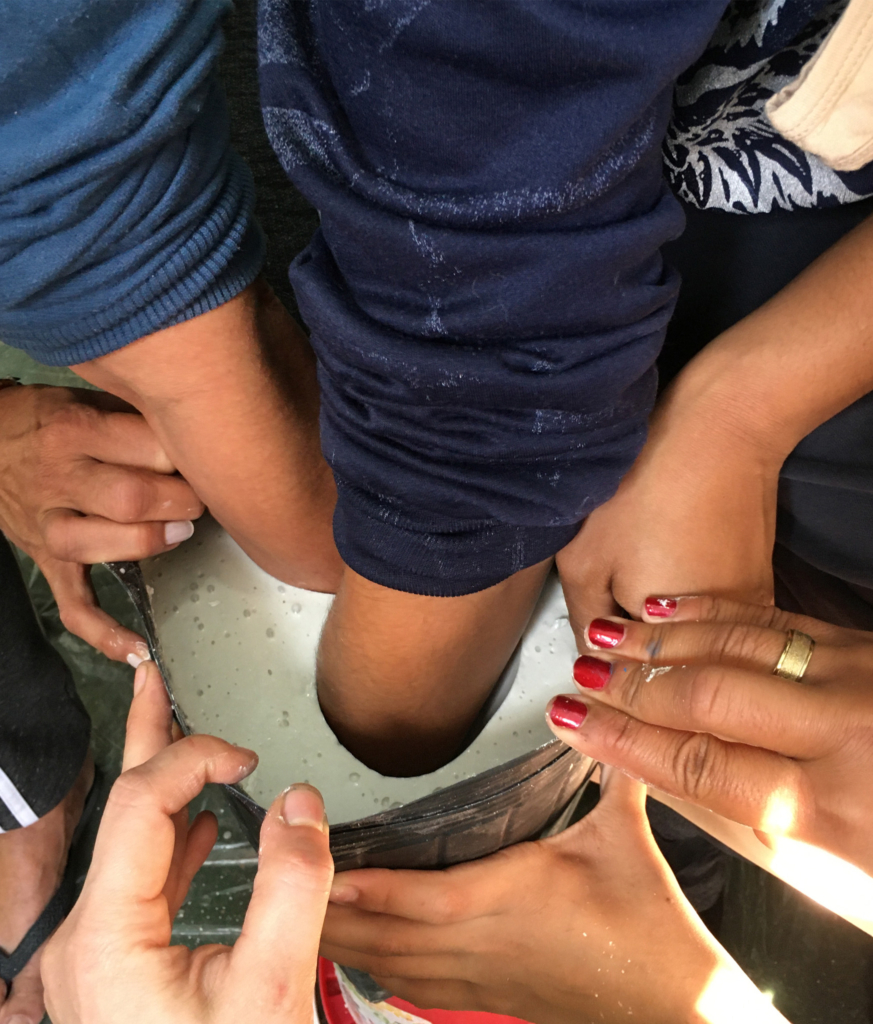
Memory-Lab Pavilion
10.09–16.10.2022
Erica Ferrari & Ana Catarina Mousinho
Memory-Lab Pavilion
10.09–16.10.2022
The Memory-Lab Pavilion by Erica Ferrari and Ana Catarina Mousinho is a participatory art installation on the C-mine site, which functions as an artist workshop, an exhibition space, and a meeting place. The pavilion is a work in progress – in the course of five weeks, the duo will organise a series of workshops and invite participants to co-create the installation.
Erica Ferrari’s practice, spanning sculpture, installations, and urban interventions, explores the interplay of politics and memory in the public space. For her project in Genk, she invited a fellow artist Ana Catarina Mousinho to co-develop the Memory-Lab Pavilion as a site for embodied, collective memory work. During their residency in Genk, Ferrari and Mousinho became intrigued by the urban- and memory-scape of Genk. Over the last two centuries, the city has transformed from a village of landscape painters into an industrial hub, and eventually, into a post-industrial cultural site. Each of these transformations has brought with it a certain degree of erasure and loss of memories. Through the project, the artists want to give space in particular to those memories and stories that have low visibility in the public space. “The right to memory is the right to public space”, they say. In contrast to official narratives petrified in monuments and rites, Ferrari and Mousinho will explore the potential of collective action and ephemeral gestures as strategies for remembering and storytelling.
The participants in the workshops are invited to explore how memories and stories can be transferred through bodily and material gestures. Ferrari and Mousinho will introduce the participants to several gestural drawing and sculpting techniques, using natural materials like clay and charcoal as well as the materials associated with construction sites, such as plaster, concrete, and debris. The focus of the workshops is not on their physical outcome, but rather, on the process of working and making together, exchanging stories, and creating new memories.
The structure of the installation, designed by Ferrari, has been inspired, on the one hand, by the infrastructure of a construction site and, on the other hand, by the pavilion as a semi-permanent, flexible architectural structure. The pavilion is located at the former mine site of Winterslag, in the area which is a palimpsest in the making. While the monumental edifice of the Energy Building and a few others are preserved, the majority of the former mine infrastructure has been demolished. It is at this location that the future house for Jester will be built. Located in-between the architectural heritage and the construction site, the Memory-Lab Pavilion becomes a space for negotiation between the past and the future.
Practical information
The installation is located on the C-mine site, behind the LUCA School of Art. The ground floor of the installation is accessible at all times. Please, treat the installation and objects you will encounter with respect. The first floor of the installation is accessible during the workshops only.
The public workshops take place on three Saturdays: 24.09, 01.10, and 15.10.22, between 1 and 4 pm. On those days, you can join a workshop or come by and meet the artists.
The objects that will be created in this process will temporarily furnish the Memory-Lab Pavilion. After the exhibition’s end, they can be retrieved by their makers.
Bios
Erica Ferrari (°1981, BR) is an artist and researcher based in São Paulo. In recent years Erica produced objects and installations from research around the relationships between architecture, space and history. She participated in individual and collective exhibitions in Brazil and abroad and received acquisitions and artistic production awards. Recent exhibitions include ‘32nd Biennial of Graphic Arts’ MGLC, in Ljubljana, Slovenia, ‘O que não é floresta é prisão política’, Reocupa Gallery of Ocupação 9 de Julho – MSTC in São Paulo, ‘Has always been dystopia’, XPO Gallery, in Enschede, Holland, ‘Estamos Aqui – Ocupação Ateliê 397’, SESC Pinheiros. São Paulo e ‘37º Panorama da Arte Brasileira’, MAM – Modern Art Museum of São Paulo, Brazil. She was artist in resident at Pivô (São Paulo), Sculpture Space in Utica (New York), GlogauAIR (Berlin), ARE Holland (Netherlands), AIR Niederösterreich (Krems, Austria) and Jester/FLACC/CIAP (Genk, Belgium). PhD Student at School of Architecture and Urbanism of University of São Paulo (FAU USP). Researcher associated to LabOUTROS – Laboratory of the Department of History of Architecture and Aesthetics of FAU USP. Collaborator of MSTC – Movement of Low Income Workers of São Paulo City Center.
Ana Catarina Mousinho (°1980, BR) is a visual artist, art educator and activist. Born in Recife, Pernambuco, lives and works in São Paulo. She has participated in solo and group exhibitions in Recife, São Paulo, Brasília and Frankfurt and in artistic residency programs in Recife, São Paulo and Brasília. From different supports, such as drawing, painting, sculpture and installations, he deals with the material found (collecting ordinary objects) or created (through paintings and drawings with a predominance of color and an excavated and gestural trace) as a means of friction of memories and a broadening of understanding about the processes of interpersonal relationships, individual history and social paths traced together. She works with the MSTC in the areas of culture, art and education. He also proposed and held art workshops in 2017 with children from Cidade Estrutural in Brasília during an artistic residency at CAL-UNB, in 2016 he promoted meetings with children to walk, draw and paint the city during a residency at l.a.m.a-sp, São Paulo and in 2016 worked at Instituto Dom Helder in Recife as an educator in the “Amarelo cor de Urubu” project.
The artists would like to thank Alicja, Orlando, Luuk, Stef, Kevin and the entire Jester team, Giselle Beiguelman and FAU/CAPES, Carmen Silva and MSTC, our families and friends for their support.
The project is realised with the support of the Flemish Community, the city of Genk, and Jester members; PROAP/CCP – Faculty of Architecture Urbanism at the University of São Paulo, and CAPES – Coordenação de Aperfeiçoamento de Pessoal de Nível Superior [Higher Education Personnel Improvement Coordination].

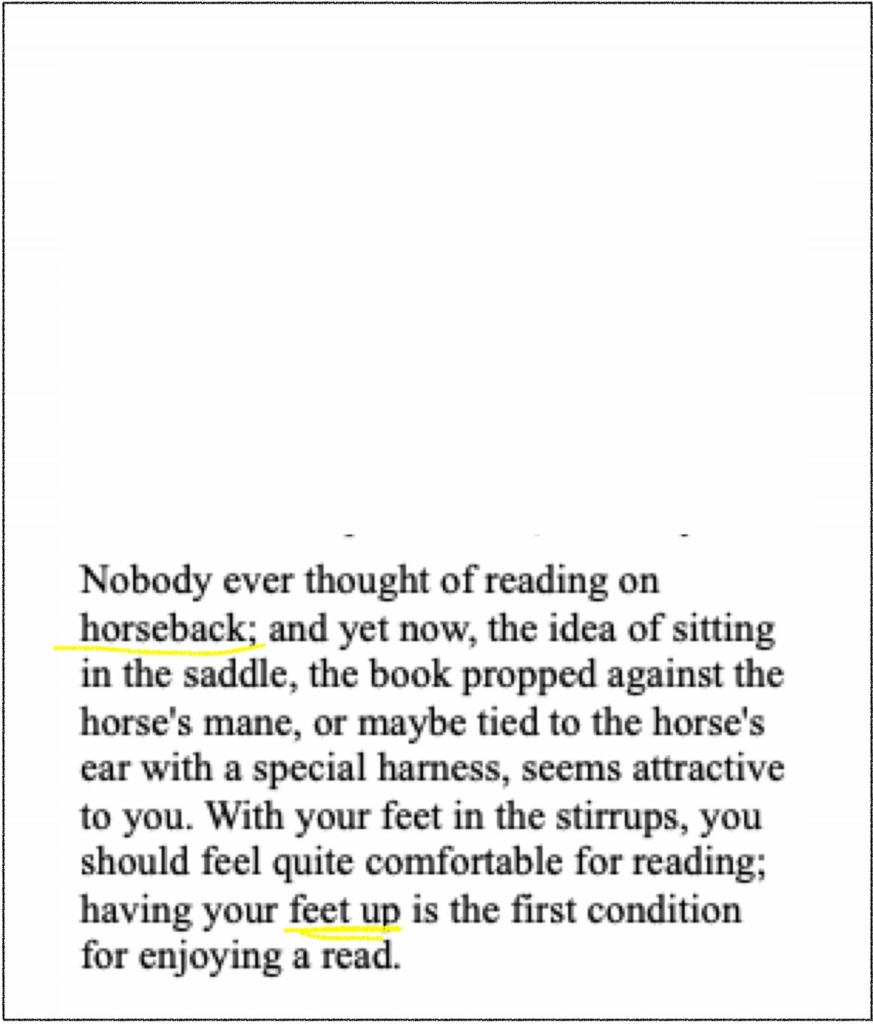
Riding High in the Reading Saddle
16–23.07.2022
Reading Group
Riding High in the Reading Saddle
16–23.07.2022
Saturday 16.07, 6-8. p.m.
Wednesday 20.07, 6-8 p.m.
Sunday 24.07, 6-8 p.m.
In If on a winter’s night a traveler, a novel from 1979, Italian writer Italo Calvino evokes the image of a reader on a horseback, moving simultaneously in two parallel worlds: the physical world and the one of the book. This ‘reader-rider’, contrasted with the stark image of a reader at a lectern, represents an emancipated audience, taking the reins and driving (or rather riding) the plot home. Not without reason, the title of Alexis Gautier’s exhibition refers to this figure. His working method can be compared to ‘collective fiction writing’ – even if the outcome is not always literary.
In parallel with Alexis Gautier’s exhibition Riding High in the Reading Saddle, we are organising a reading group which takes Italo Calvino’s novel as a point of departure. Over the course of three evenings, we will explore the potential of non-linear storytelling, collective reading, and situated literacy. The workshop is a collective engagement and will be moderated by Jester’s curator Alicja Melzacka.
The workshop is free. The texts that we read are written in English, therefore the sessions will be held in English (no proficiency is required and we also speak Dutch). Please subscribe before the 11th of July – the specific plan will be tailored to the number of participants. You can mail alicja@jester.be to confirm your participation.


Open studio
14–15.05.2022
Jester
Open studio
14–15.05.2022
On the 14th and 15th of May, the open studio weekend for visual artists all over Flanders and Brussels, Jester (former FLACC/CIAP). We offer you a sneak peek at our the different workshops: like the ceramics, the metal and the digital studio. During your visit we offer you a unique inside in the methodology of our Artist in residence: Arjun Das (IN) and in the ceramics studio, we present work in progress by Sarah van Sonsbeeck (NL). Simultaneously in the ceramics workshop, we cast the new Jester coffee mugs in moulds and invited an artist to use the turntable.
Not only do our residents find their way to our studios, but also many other artists and makers rent our facilities to create projects that have specific technical needs. Interested in getting started? During our Open Studios, we present the studio formulas and our team members can help you out with practical questions you may have. On Saturday the 14th of May, we also present our collaboration with vzw Het Steger in the form of a community kitchen. Feel free to take a look at the café and order a special snack and drink!
PROGRAMME
Saturday & Sunday the 14th & 15th of May, 1 till 5 p.m.
Arjun Das – open studio
Arjun Das (IN) comes from a family of migrant workers who travelled through India in their search for work. During his working period, he wants to get in touch with migrant workers in Genk and transform their stories into woodcuts and other works. For this project, he mainly woks with used materials, such as reclaimed wood.
Sarah van Sonsbeeck- presentation work in progress in the ceramic studio
Sarah van Sonsbeeck (NL) is interested in monuments, and in particular in ‘accidental monuments’: objects that are given a role in remembering and commemorating because of certain events. She asks questions like “Why don’t monuments change when our thinking about important themes and historical events does?”
Activated ceramics studio
In the ceramics workshop, there is even more to see. We cast the new Jester coffee mugs, and we invite an artist to use the turntable.
Community kitchen in the café * Only on Saturday
In the café we present our collaboration with vzw Het Steger in the form of a community kitchen. Feel free to take a look and order a yummy snack and drink!
PRACTICAL INFORMATION
On Saturday and Sunday the 14th and 15th of May, we open our doors between 1 and 5 p.m. The admission is, of course, free of charge. Location: Casino Modern, André Dumontlaan 2, 3600 Genk.




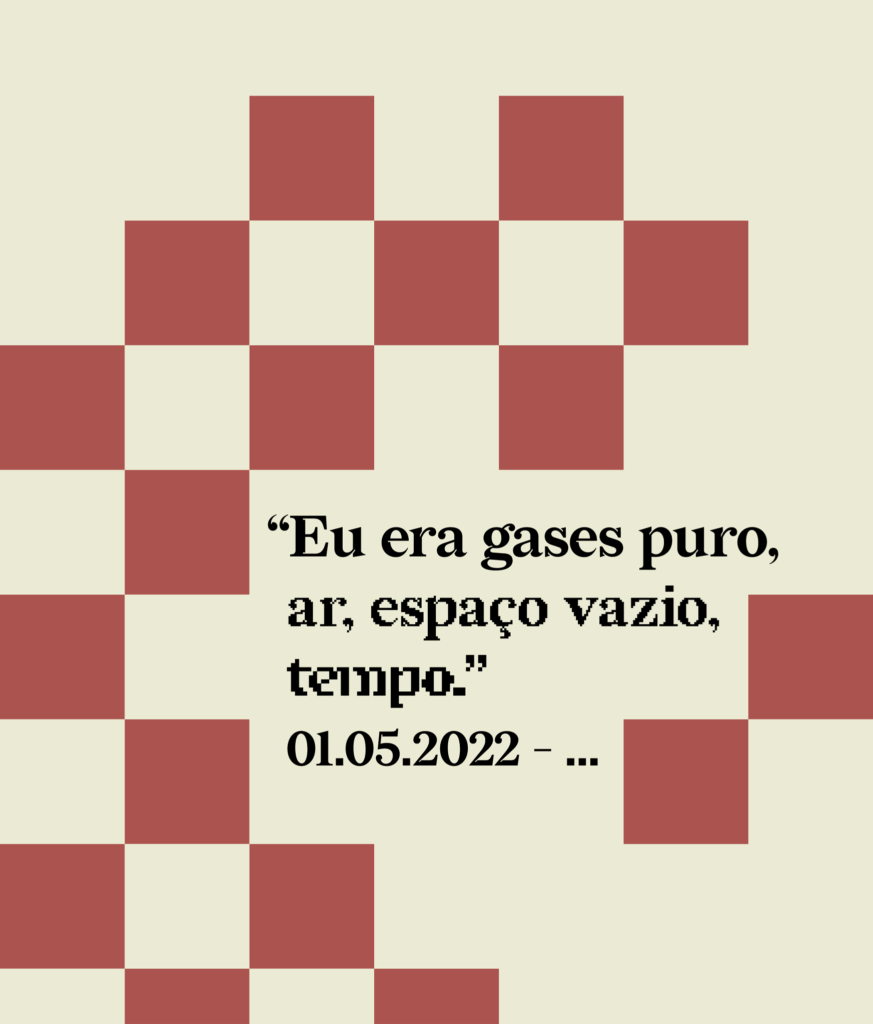
Edition Launch
01.05.2022
Three Tropes for Entropy
Edition Launch
01.05.2022
“Eu era gases puro, ar, espaço vazio, tempo.”
“I was pure gas, air, empty space, time.”
01.05.2022 – …
You are kindly invited to the third and final event of Three Tropes for Entropy. The third trope of the exhibition will take the form of a collective edition. The launch will be held at the studio of Angyvir Padilla this Sunday, 1st of May, from 1-7pm.
The edition’s presentation marks the dissolution of the transformative exhibition, an outcome of the Lichen Curatorial Prize 2021-22, organized by Jester (former FLACC/CIAP) and Curatorial Studies KASK. This final gesture of launch introduces an indetermination to the exhibition process, which has no fixed end date but keeps existing in different forms, like molecules of gas once compressed into a condensed space and suddenly freed into the ambient.
The collective edition includes three printed pieces. Created by Angyvir Padilla, mountaincutters and Daniel Steegmann Mangrané, all prints stem from the textual practice embedded in the artists’ processes:
Executed in reflective, translucent ink and supplemented with a handmade match that activates the reflection effect in the dark, the silkscreen print by Angyvir Padilla borrows verses from the poetry of Argentinian writer Alejandra Pizarnik. The final result is a print that can be activated as an instalative piece.
The inkjet prints by mountaincutters were presented in the exhibition – first in Jester’s exhibition space and later moved to C-mine’s compressor’s hall for the second trope of the exhibition. Every print carries a unique poem written by the artist duo and is supplemented with magnets for hanging.
Executed in graphite ink, the recto-verso silkscreen print by Daniel Steegmann Mangrané shows an excerpt originally coming from Stella do Patrocínio’s oral poetry, defined by her as acts of gabbling. Compulsorily admitted into a mental asylum, Stella do Patrocínio was a maker of poems that were never written down but took visual form through the interpretation of Steegmann Mangrané. Mirrored, oblique, fractured, and incised, the typography remains translucent and void—as light as thin air, like gas, as the empty space and time evoked by the self-description of Stella do Patrocínio.
All silkscreen pieces are exquisitely printed by Camping Penrose / Liselotte van Daele.
PRACTICAL INFORMATION:
The edition launch takes place at the studio of Angyvir Padilla during the 38st Art Brussels weekend on Sunday the 1st of May from 1 to 7 p.m. You can find us at the following address: Jennartstraat 46, 1080 Sint-Jans-Molenbeek, Brussels.
Lichen is a prize for emerging curators, established by Jester (former FLACC/CIAP) and the department of Curatorial Studies at KASK School of Arts to foster and support curatorial experimentation in Belgium. With the support of the Flemish Community, the City of Genk, and the Jester members.
Related Projects







